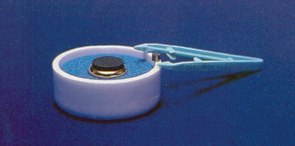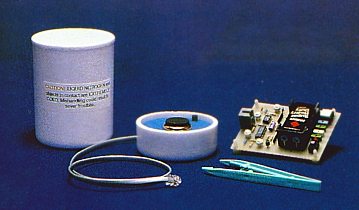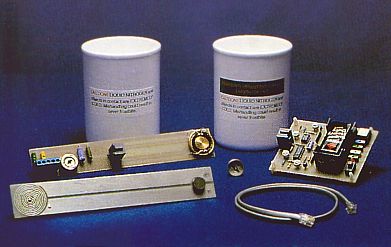
From 1994 until early 2006, Futurescience, Inc. sold several superconductor kits using the Yttrium Barium Copper Oxide "high temperature" superconducting ceramic material. All these superconductor kits required liquid nitrogen. Futurescience, Inc. was dissolved in 2007, and the remnants of its operations (including the operation of this web site) have been taken over by Futurescience, LLC, a company that was founded in early 2008 by the person who made all of the superconducting disks and rings for Futurescience, Inc.
WE CANNOT ACCEPT NEW ORDERS FOR SUPERCONDUCTOR KITS. This is strictly an archive page.
VERY IMPORTANT NOTE: We are not accepting any new orders for Futurescience superconductor kits. The official period of support for these kits has long since passed. Jerry Emanuelson is always glad to try to answer relevant questions from those who have purchased the Futurescience kits in the past, however the availability of any spare parts for those kits (with perhaps a few exceptions) has come to an end.
It is our intention that the documentation about our former superconductor products will remain online for a long time. This page is being left in place as a possible convenience to our former customers. It also contains links to other Futurescience pages that may be of interest to anyone interested in superconductivity.
For information about how to make superconductors in a high school or university science laboratory, see the detailed page on Making Superconductors. Also see Jerry Emanuelson's Introduction to High-Temperature Superconductors. The manuals for our old superconductor kits, which are linked to farther down on this page, also provide a large amount of information about high-temperature ceramic superconductors.
Anyone planning to do a superconductor science project who is not a science teacher, or is not familiar with superconductors, should read the Superconductor Science Projects page. We cannot offer any individual advice on such superconductor projects. When we have done so in the past, we have ended up giving away many valuable hours of time for free in each individual cast.
Manuals for these kits that we produced in the past are available by clicking on the designated links below. Although these manuals are copyrighted, permission is granted to print out any reasonable number of copies for use with the kits, or for any classroom or laboratory use within your educational institution.
Kits that we produced in the past include:
 Model 150 Magnetic Levitation Kit. This basic kit included an yttrium-barium-copper-oxide superconductor mounted on a copper pedestal in an insulated dish. Also included was a rare-earth magnet, plastic forceps and a comprehensive manual.
Model 150 Magnetic Levitation Kit. This basic kit included an yttrium-barium-copper-oxide superconductor mounted on a copper pedestal in an insulated dish. Also included was a rare-earth magnet, plastic forceps and a comprehensive manual.
(Note: In later years, these kits included the larger 0.5" (12.7 mm.) diameter rare-earth magnet in the Model 150 kits instead of the smaller magnet that we previously used.
The Model 150 Instruction Manual is on line. An Adobe Acrobat version of this manual is also available.
 Model 250 Magnetic Levitation Kit with temperature sensor. With this kit, you can demonstrate magnetic levitation and determine the critical temperature of the superconductor by measuring the temperature at which the magnet begins to levitate. The kit included a YBCO superconductor with an imbedded temperature sensor, an electronics board for converting the output of the temperature sensor to degrees Celsius or degrees Kelvin as measured on any digital voltmeter (which must be supplied by the user), a neodymium-iron-boron magnet, plastic tweezers and a manual.
Model 250 Magnetic Levitation Kit with temperature sensor. With this kit, you can demonstrate magnetic levitation and determine the critical temperature of the superconductor by measuring the temperature at which the magnet begins to levitate. The kit included a YBCO superconductor with an imbedded temperature sensor, an electronics board for converting the output of the temperature sensor to degrees Celsius or degrees Kelvin as measured on any digital voltmeter (which must be supplied by the user), a neodymium-iron-boron magnet, plastic tweezers and a manual. (Note: in later years, these kits included the larger 0.5" (12.7 mm.) diameter rare-earth magnet in the Model 250 kits instead of the smaller magnet that we previously used.)
The Model 250 Instruction Manual is on line. An Adobe Acrobat version of this manual is also available.
Model 1000: Resistance and Persistent Current in a Ring.

The Model 1000 Instruction Manual is still on line.

Model 500 Resistivity vs. Temperature Kit. This was one of our later kits designed for those who wish to do only the Resistivity vs. Temperature Measurements. The electronics board is identical to the model 1000 kit above, but the superconductor probe used a superconducting bar rather than a ring. (The magnet, magnet holder probe, and compass are not necessary for resistivity measurements, and were not included.) The superconducting bar is more rugged than the ring; and, therefore, is better for school laboratory use where students are subjecting the superconductor to repeated thermal cycling between room temperature and liquid nitrogen temperature. This kit required a digital voltmeter and a small DC power supply to be supplied by the user. Note: A printed manual was not included with the special edition Model 500 kit, and was never available. Please download the manual from this web site. An Adobe Acrobat version of this manual, and others, is also available.
The Model 500 Instruction Manual is on line. This manual includes illustrations and will take a minute or two to load unless you have a high-speed connection.
If you are a student or parent interested in using our kits for a school or science fair project, please see our notes about superconductors for school projects.
Note: Be sure to keep the superconducting disks and rings out of the reach of children. The superconducting material can be hazardous if swallowed since stomach acid reacts with the material to form toxic barium chloride.
A satisfactory demonstration of the superconductor magnetic levitation effect requires a rare-earth magnet. Magnets were included in the levitation demonstration kits. Small rare earth magnets are no longer difficult to find.
Please send email inquiries to: Jerry Emanuelson